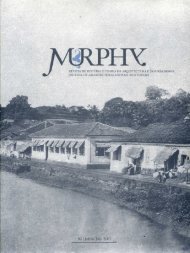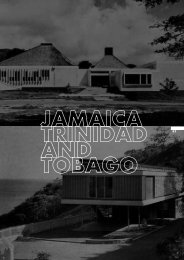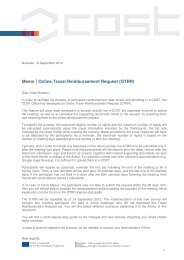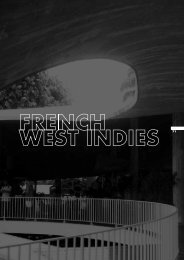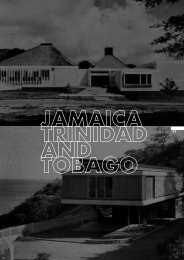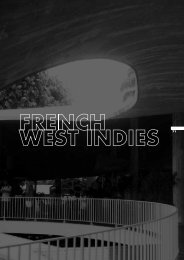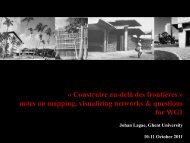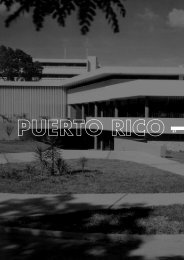Santo Domingo, Modernity and Dictatorship
Santo Domingo, Modernity and Dictatorship
Santo Domingo, Modernity and Dictatorship
Create successful ePaper yourself
Turn your PDF publications into a flip-book with our unique Google optimized e-Paper software.
56<br />
these ensembles is seen in the design of their buildings<br />
<strong>and</strong> in their urban installations, but not in their conception<br />
of space or their management of vehicular traffic.<br />
Trujillo compromised Dominican modernity when he<br />
commissioned a catalogue of works representing the<br />
regime throughout the country. Gázon Bona created a<br />
‘Trujillista’ typology of Dominican architecture in a series<br />
of projects in San Cristobal, where he built hotels,<br />
housing projects <strong>and</strong> schools; in Santiago with his<br />
Monument to Peace of Trujillo <strong>and</strong> dozens of ‘palaces;’<br />
<strong>and</strong> in the frontier region where he designed hotels,<br />
barracks, municipal government buildings, law courts<br />
<strong>and</strong> branch offices of the Dominican party.<br />
<strong>Santo</strong> <strong>Domingo</strong> never had a structured vision of a modern<br />
city (or to be exact, of any kind of city), unlike Cuba<br />
during Machado’s dictatorship, for whom Forestier<br />
worked, as he also did in Argentina. 13 In reality, the city’s<br />
urban project appears to be only the sum of independent<br />
<strong>and</strong> punctual works, linked to the city to optimize <strong>and</strong><br />
adapt it to the new times without touching to the historical<br />
center, as José Lluís Sert proposed for Havana in 1959. 14<br />
The architect Ramón Vargas Mera, author of the<br />
Regulating Plan for <strong>Santo</strong> <strong>Domingo</strong> in 1956 recognized<br />
a bit of this when he wrote: “Demolishing the historical<br />
center <strong>and</strong> building towers in its place is not what is<br />
proposed. The center is to be respected, with its<br />
architectural <strong>and</strong> urban values.” 15<br />
Vargas Mera was the only one to dem<strong>and</strong> a vision of a<br />
modern city for <strong>Santo</strong> <strong>Domingo</strong>. Nevertheless, his vision<br />
questioned orthodox modern urbanism, as he noted<br />
when writing about the plan: “The system of zoning<br />
according to function, central to the CIAM <strong>and</strong> the Athens<br />
Charter, is to be substituted by a system of mixed zoning<br />
in which the predominant activity will stimulate the<br />
character of the zone <strong>and</strong> secondary activities will<br />
complement the zone’s use.” 16<br />
The fact that Vargas Mera’s plan was rejected, once it<br />
conflicted with the regime’s political interests, reaffirmed<br />
the refusal of political will to conceive of the city as an<br />
integrated whole. This attitude continues today.<br />
AFTER THE FALL of the Trujillo regime in 1961, <strong>Santo</strong><br />
<strong>Domingo</strong> recovered its name <strong>and</strong> became an open city<br />
which continues to enforce its vision of modernity.<br />
However, it has still not drawn up a master plan, <strong>and</strong> we<br />
continue to hope to see it converted into a better city.<br />
Although modernism was practiced during the Trujillo<br />
era, a modern city, participatory, functional <strong>and</strong><br />
democratic, remains to be constructed. Joaquín Balaguer,<br />
elected president with the support of the invading troops<br />
of the Organization of American States, was more<br />
interested in the colonial city, bad housing <strong>and</strong> large<br />
parks. Nor have subsequent governments really involved<br />
themselves in the city. And so, after five centuries, <strong>Santo</strong><br />
<strong>Domingo</strong>, lying by the Ozama River, still awaits a<br />
contemporary identity, which has yet to arrive.<br />
OMAR RANCIER, architect, graduated cum laude from the University<br />
Autónoma of <strong>Santo</strong> <strong>Domingo</strong> in 1979. President <strong>and</strong> founder of the<br />
group Neuvarquitectura, organizer of architectural biennials in <strong>Santo</strong><br />
<strong>Domingo</strong>, author of numerous articles <strong>and</strong> essays in <strong>Santo</strong> <strong>Domingo</strong>'s<br />
major specialist journals, professor at the school of architecture at<br />
the University Pedro Henríquez Ureña (UNPHU). Omar Rancier was also<br />
director of the Faculty of Architecture at the University Iberoamericana<br />
(UNIBE).<br />
Translated by Jon Kite<br />
NOTES<br />
1 Colin Rowe, Fred Koeter, Ciudad Collage (Barcelona: GG, 1981), 34.<br />
2 Eugenio Pérez Montas, La Ciudad del Ozama (Barcelona: Patronato<br />
de la Ciudad Colonial de <strong>Santo</strong> <strong>Domingo</strong> & Centro de Altos Estudios<br />
Humanísticos y del Idioma Español, 1999), 284.<br />
3 Ibid., 283. Taken from J. Chez Checo, El Palacio Nacional de<br />
la República Dominicana: 50 Años de historia y arquitectura (<strong>Santo</strong><br />
<strong>Domingo</strong>: Secretaria Administrativa de la Presidencia, 1997).<br />
4 Virgilio Vercelloni, Atlas Histórcio de <strong>Santo</strong> <strong>Domingo</strong> (Milan:<br />
Cosmopoli, 1991).<br />
5 Architect Ramón Martinez, “El Significado de la Arquitectura de<br />
la Era de Trujillo,” paper presented at Arquitectura Contemporanea<br />
en la República Dominicana, organized by the Grupo<br />
Nuevarquitectura (Casa de Teatro, September 4–6, 1981).<br />
6 “In its time, by which it was inspired, the typical neoclassicism was<br />
born, which was extremely characterized by its lines. These limpid<br />
creations resemble a past overflowing with tradition <strong>and</strong> nationality.”<br />
Henry Gazón Bona, La Arquitectura Dominicana en la Era de Trujillo<br />
(Collection Henry Gazón Bona, 1949), 1.<br />
7 Architect Ramón Martinez, “El Significado de la Arquitectura de<br />
la Era de Trujillo,” paper presented at Arquitectura Contemporanea<br />
en la República Dominicana, organized by the Grupo<br />
Nuevarquitectura (Casa de Teatro, September 4–6, 1981).<br />
8 Omar Rancier, “Versatilidad estilistica en la Arquitectura<br />
de Guillermo González,” Nuevarquitectura 43, El Siglo (February 23,<br />
1990): 6B.<br />
9 Silvia Hernández de Lasala, Malaussena: Arquitectura Academica<br />
en la Venezuela Moderna (Caracas: Editorial ExLibris, 1990), 20.<br />
10 Leonardo Benevolo, Historia de la Arquitectura Moderna<br />
(Barcelona: Gustavo Gili, 1982), 100.<br />
11 Engineer José R. Báez López-Penha, “<strong>Santo</strong> <strong>Domingo</strong>:<br />
Su Fundación y Crecimiento,” paper presented at the round table<br />
on urban planning (National University Pedro Henriquez Ureña,<br />
July 6–8, 1972). Codia 26, May/August 1971.<br />
12 Gustavo Luis Moré, “Guillermo González: A los 82 años de<br />
su nacimiento,” Hoja de Arquitectura 26, “El Nuevo Diario”<br />
(November 1, 1982).<br />
13 Jean-François Lejeune, “The City as L<strong>and</strong>scape: Jean Claude<br />
Nicolas Forestier <strong>and</strong> the Great Urban Works of Havana,<br />
1925–1930,” The Journal of Decorative <strong>and</strong> Propag<strong>and</strong>a Arts 22<br />
(Cuba, 1996): 165.<br />
14 Mario Coyula, “Influencias Cruzadas Cuba/EUU en el medio<br />
construido: Carril dos, o autopista en dos sentidos?,” Archivos<br />
de Arquitectura Antillana, Year 5, No. 10 (June 2000): 121.<br />
15 Ramón Vargas Mera, “Tendencias Urbanisticas in America Latina<br />
y el Caribe: La Situacion a Finales del Siglo XX,” Amigo del Hogar<br />
(<strong>Santo</strong> <strong>Domingo</strong>, 2004): 73.<br />
16 Ibid.<br />
Docomomo N°33<br />
September 2005



